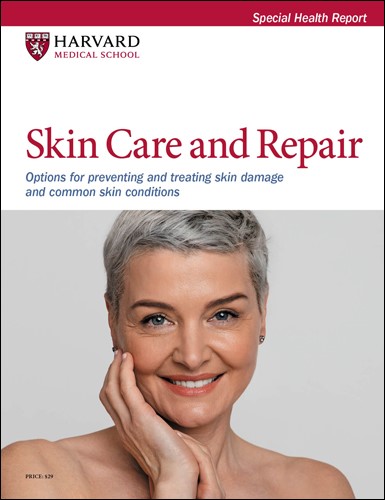Check out your skin
A routine full-body skin exam can catch early skin cancer and other potential problems.
- Reviewed by Howard E. LeWine, MD, Chief Medical Editor, Harvard Health Publishing; Editorial Advisory Board Member, Harvard Health Publishing

You probably look at your face in the bathroom mirror a couple times each day. But do you ever take a close-up look at your entire skin? Devoting time to regular full-body check-ups can help you identify abnormalities that may signal skin cancer.
"Many skin spots and growths are related to normal aging and are not cause for concern," says Dr. Abigail H. Waldman, director of the Mohs and Dermatologic Surgery Center at Harvard-affiliated Brigham and Women's Hospital. "But you should note and monitor anything new or unusual."
Do a self-check
Dr. Waldman recommends doing a head-to-toe self-exam every three to six months. Use a full-length mirror, plus a handheld mirror for hard-to-see spots, and a magnifying glass to examine smaller areas. "If possible, have someone assist you so you don't miss anything," says Dr. Waldman. Here's how to do it.
- Look at your face, neck, ears (especially behind them), and scalp. Use a comb or a blow dryer to move your hair so that you can see better.
- Look at the front and back of your body in the mirror. Then, raise your arms and look at your left and right sides.
- Bend your elbows. Look carefully at your fingernails, palm and back of each hand, forearms (including the undersides), and upper arms.
- Check the back, front, and sides of your legs. Also, check the skin all over your buttocks and genital area.
- Sit and examine your feet, including the soles of your feet, the spaces between your toes, and your toenails.
Note any new or questionable moles, sores, painful or itchy spots, raised or firm bumps, dark flaky patches, and black or brown lines along fingernails and toenails. Make sure to feel any suspicious areas for firmness, too. "We often feel something troubling before we see it," says Dr. Waldman.
Write down the date of your self-exams and record what you find, including the exact locations. Take photos with your phone to share with your doctor or dermatologist. "After six to eight weeks, look at the trouble spots again, and get them checked out if they have not improved, or have changed color or size, have become painful, or easily bleed," says Dr. Waldman.
Cosmetic changesFather Time brings us wrinkles, lines, bags under the eyes, age spots, raised rough lesions, and sagging skin. Many cosmetic treatments can treat these issues, such as botulinum toxin (Botox) injections, chemical peels, freezing liquid nitrogen sprays, laser treatments, prescription creams, and plastic surgery. Speak with your dermatologist about available options. |
Looking for skin cancer
Melanoma is the most lethal type of skin cancer, and the earlier you can catch it, the better the outcome. The first sign of melanoma is usually a change in an existing mole. However, it also may appear as a new mole. Melanoma often appears on sun exposed areas, however, it also can occur in areas protected by the sun like nails. To recognize possible melanoma, follow the ABCDE guide:
Asymmetry: the shape of one half doesn't match the other half
Border: ragged or blurred edges
Color: red, brown, blue, black, or white, and the shades may be uneven
Diameter: about a quarter of an inch or larger, although some can be smaller
Evolution: any changes in size, shape, or color.
Here are some other skin issues to look out for during your self-exam:
Freckles. Monitor large, irregular ones. If they grow or change appearance, this can be a prelude to a specific form of melanoma called lentigo maligna melanoma. Problem freckles often appear on the face, upper shoulders, chest, and arms.
Basal cell carcinoma (BCC) and squamous cell carcinoma (SCC). "Both are types of skin cancer, but they are slow-growing, usually not life-threatening, and easy to treat if caught early," says Dr. Waldman. BCC may look like a bleeding pimple, an open sore, a red patch, a shiny pink growth, or a scar. SCC resembles a crusted, scaly red bump, patch, or wart. Both cancers appear in areas frequently exposed to the sun, such as the face, rim of the ear, lower lip, balding scalp, neck, hands, arms, shoulders, back, and legs.
Actinic keratoses (AKs). These growths are rough, gritty, and sometimes painful. They can be flat or slightly raised and appear in different colors, such as red, tan, pink, skin-colored, brown, or silver. AKs often appear on the face, tips of the ears, bald spots, and backs of the arms and hands. "While AKs are not initially dangerous, get them looked at, as they may lead to squamous cell carcinoma if left alone," says Dr. Waldman.
Image: © CasarsaGuru/Getty Images
About the Author

Matthew Solan, Executive Editor, Harvard Men's Health Watch
About the Reviewer

Howard E. LeWine, MD, Chief Medical Editor, Harvard Health Publishing; Editorial Advisory Board Member, Harvard Health Publishing
Disclaimer:
As a service to our readers, Harvard Health Publishing provides access to our library of archived content. Please note the date of last review or update on all articles.
No content on this site, regardless of date, should ever be used as a substitute for direct medical advice from your doctor or other qualified clinician.
















